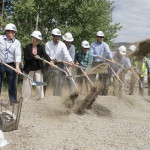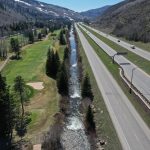Summit County resident Patrick Sweeney bikes Mount Everest
Special to the Daily
1,000 tents in 100 days
Shortly after part-time Summit local Patrick Sweeney became the first adventurer to bike to Mount Everest base camp, a magnitude 7.8 earthquake ravaged Nepal. Now, he wants to give back. He launched a non-profit foundation to supply tents for up to six people while small, high-alpine towns are rebuilt. To donate, see the foundation website at 1000tents100days.com.
Often, the ripest fruit in life can be some of the most difficult to acquire. Patrick Sweeney, an avid outdoorsman and former Olympic trial rower, knows about going to great lengths in pursuit of a plum goal.
Despite limited mountain biking experience, the part-time Summit County local successfully rode the entire Iditarod trail in Alaska a few years back. While on this adventure, Sweeney asked his friend about the biggest untried challenge in mountain biking.
“He immediately said Mount Everest — riding up to base camp,” Sweeney explained. “It was so outlandish that I fell in love with the idea immediately.”
There, the seed was planted.
The journey

Support Local Journalism
Although it’s been attempted in the past, no one has ever made it to Mount Everest base camp on a mountain bike. In one previous attempt, bikers were even shot at before the Nepali Military confiscated their wheels.
To avoid the same risks, Sweeney petitioned the Nepali government to grant him a permit, which would allow him to ride a bike in historic Sagamartha National Park — the gateway to Mount Everest’s southern base camp through the portal town of Gorakshep. After countless Skype calls and 14 months of explaining the trip to his wife and the Nepali government, Sweeney was finally granted an eight-day window in February 2015 to make the voyage.
Beginning at 9,000 feet in Nepal on Feb. 18, Sweeney departed on a mission that would take him over countless mountain passes, gaining nearly 40,000 vertical feet while riding through some of the most difficult terrain anyone has ever tackled on a bike. He estimates that about half of the journey was spent carrying his bike up slopes too steep to pedal, and, as if that wasn’t enough, at around 16,500 feet his hydraulic brakes gave out due to the extreme air pressure. He still had more than 1,000 vertical feet to climb and descend.
“Coming down was a complete nightmare,” Sweeney said. “I did a lot of foot dragging, a lot of jumping off my bike at the last minute. The bike rode me a lot more than I rode the bike.”
But, even with daily slogs up impossibly steep pitches, more than a handful of flat tires and constant gasping for breath, the breathtaking scenery surrounding Sweeney often took his mind off the arduous task at hand.
“It’s incredibly rugged, and on the other hand it’s so mystical,” Sweeney said. “You go over a hill and you see thousands of prayer flags. You climb over this peak and you’re just dying, and then, all of sudden, you see this stuff someone took months to carve out the prayer in the rock.”
While on his mission, Sweeney built a deep connection with many of the people he met in Nepal, often bonding over the topic of his bicycle. Many wide-eyed farmers and sherpas mistook it for a motorcycle, while the kids there had never seen anything like it at all.
“I had kids chasing me across suspension bridges, kids wanting to touch the bike, monks at the monastery trying to ride it,” Sweeney said.
Through screeching, monkey-filled temples, herds of yak and wooden bridges strung over 1,000-foot precipices, Sweeney traveled on. Finally, on the morning of Feb. 24, drenched in sweat and gasping for air, Sweeney arrived at base camp. After only six and a half days, Sweeney had accomplished the improbable.
But his celebration was modest. With no one else around to share his accomplishment — Everest’s peak climbing season is in late spring — Sweeney left the dangerously thin air soon after, making for a rather anti-climatic ending to an otherwise incredible voyage.
“I took some pictures and video and then got out of there,” Sweeney said. “There’s not usually people at the end of these adventure pursuits for a reason.”
Yet Sweeney’s voyage was just beginning.
Disaster strikes
On April 25, nearly two months to the day after Sweeney reached base camp, a magnitude 7.8 earthquake struck Nepal.
“Initially, my reaction was for the friends I made over there,” Sweeney said. “I immediately thought, ‘What happened to them, what happened to their families?’ It took six to eight weeks to hear from everybody.”
The earthquake was a disaster of unfathomable proportions, killing nearly 9,000 people and injuring another 27,000 Nepali residents and visitors. On his trek, Sweeney made friends with a monk named Tashi Lama. Lama runs the Little Sherpa Foundation, an organization dedicated to paying educational costs for children of sherpas who have died. Lama survived the catastrophe, and, through him, Sweeney was given a snapshot of a poor, impoverished Nepal turned upside-down by a natural disaster: Nearly three-quarters of Lama’s hometown, Potesay, was completely destroyed and the monk’s father was injured.
After an initial flurry of media coverage, Nepal was all but forgotten in the headlines. Even five months later, many of the rural Himalayan villages Sweeney traveled through still have not received relief, due in equal parts to difficult travel and corruption. The residual effects of any natural disaster — concerns such as water contamination, hunger and rampant homelessness — still sweep the land. A lack of shelter is particularly concerning with monsoon season fast approaching. Few residents, if any, can afford to rebuild.
When a newfound awareness of Nepal’s primitive culture before the earthquake and a personal connection to the mass destruction thereafter, Sweeney realized he had to take action.
“I thought to myself, ‘My god, it’s like shooting fish in a barrel,’” Sweeney said. “Their lifestyle is all sustainment. All they’re doing is growing potatoes.”
1,000 tents in 100 days
In July, Sweeney launched a nonprofit campaign to raise 1,000 tents in 100 days for victims of the Nepal earthquake.
“All the money is going directly to help the people,” Sweeney said. “It basically houses one of these families for the next few years, until they get their housing rebuilt.”
For $250 — roughly the cost for a weekend of skiing — anyone can sponsor a tent that becomes a home for up to six people. So far, Sweeney has raised about 130 tents. He has already mailed a few directly to Tashi Lama, but he plans on returning to Nepal in November to hand-deliver the majority of the tents, along with a few computers and printers specifically for the Little Sherpa Foundation. The adventurer has been involved with charitable causes before, but this time, the need hit much closer to home.
“It’s never been something that’s really touched me, but going to Nepal and meeting those people and then hearing their stories,” Sweeney said and paused. “If I can look back five years from now and realize that our charity did some good rebuilding the country, then I’ve had a huge impact on the world.”
Sweeney will accept donations of any size. He realizes that raising enough money by his initial goal of Oct. 1 is a formidable challenge, but adversity in life has rarely been a deterrent.
“If we just get one tent to one family, that’s six lives we’ve changed,” Sweeney said. What started as a personal adventure has now become a charitable mission, and, not surprisingly, the top of the mountain keeps getting higher with every step he takes.
“There’s two things that are way out there,” he said. “There’s the moon and Mount Everest, and I haven’t figured out how to mountain bike on the moon yet.”
























